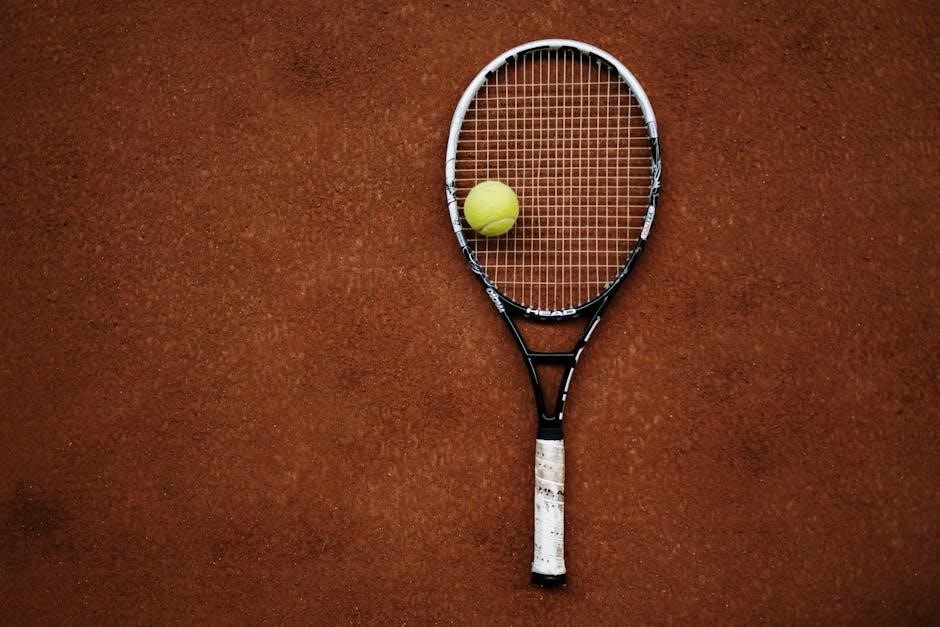tennis drills for beginners pdf
Tennis Drills for Beginners PDF: A Comprehensive Guide
Embark on your tennis journey with our comprehensive PDF guide, designed specifically for beginners. This resource provides structured drills to build a solid foundation. Learn essential techniques, enhance your skills, and enjoy the game with confidence. Download now and start your tennis adventure!
Welcome to the exciting world of tennis! This guide focuses on introducing beginner tennis players to effective drills that will form the bedrock of their skills. Tennis can seem daunting at first, but with the right approach and consistent practice, anyone can learn to play and enjoy this fantastic sport. This section will cover the importance of starting with fundamental drills designed to build confidence and competence on the court.
We’ll explore why drills are essential for developing proper technique, improving consistency, and enhancing overall game awareness. These drills are not just about hitting the ball; they are about learning the correct movements, understanding court positioning, and developing strategic thinking. By focusing on the basics, you’ll avoid developing bad habits that can be difficult to correct later on.
This introduction will also touch on the benefits of using a structured PDF guide, which allows for easy access to a variety of drills and exercises. A well-organized guide can provide clear instructions, visual aids, and progressive steps to help beginners learn at their own pace. Whether you’re a complete novice or have some experience, these drills will help you build a solid foundation for your tennis journey. Get ready to improve your game and have fun on the court!
Essential Equipment for Beginner Tennis Drills
To make the most of your beginner tennis drills, having the right equipment is crucial. While you don’t need to break the bank, investing in a few essential items will significantly enhance your learning experience and performance on the court. First and foremost, a suitable tennis racquet is paramount. Beginners should opt for a lightweight racquet with a large head size, as this provides a larger sweet spot and greater forgiveness on off-center hits.
Next, tennis balls are obviously a must-have. Regular duty tennis balls are ideal for softer court surfaces, while extra duty balls are better suited for hard courts. Having a sufficient supply of balls ensures that you can practice drills without constantly stopping to collect them. A tennis bag is also a valuable investment, providing a convenient way to carry your racquet, balls, water bottle, and other accessories.
Comfortable athletic shoes are another essential piece of equipment. Look for shoes that offer good support and cushioning to prevent injuries and allow for quick movements on the court. Appropriate athletic wear, such as moisture-wicking shirts and shorts, will also help you stay comfortable and focused during your drills. Finally, consider bringing accessories like a hat or visor to protect yourself from the sun, and sunscreen to shield your skin. With the right gear, you’ll be well-prepared to tackle any beginner tennis drill and make steady progress.
Grip and Stance Fundamentals
Mastering the grip and stance is absolutely fundamental for any beginner tennis player. These two elements form the bedrock upon which all other skills are built. Let’s start with the grip. There are several different grips in tennis, but for beginners, the continental and semi-western grips are often recommended for their versatility. The continental grip is excellent for serving, volleys, and defensive shots, while the semi-western grip is well-suited for hitting powerful forehands with topspin. Experiment with both to see which feels more natural and comfortable.
Now, let’s move on to the stance. The ready position is your starting point before each shot. Stand with your feet shoulder-width apart, knees slightly bent, and your weight balanced on the balls of your feet. Hold the racquet in front of you with both hands. As the ball approaches, you’ll need to adjust your stance to prepare for the shot. For forehands, the open stance is commonly used. This involves positioning your body sideways to the net with your front foot pointing towards the direction you want to hit the ball. For backhands, the closed stance is often preferred, where your body is more parallel to the baseline.
Remember that the grip and stance are interconnected. A proper grip allows you to generate power and control, while a solid stance provides a stable base for your swing. Practice these fundamentals diligently, and you’ll be well on your way to developing a consistent and effective tennis game.
Basic Forehand Groundstroke Drills
Developing a solid forehand groundstroke is essential for any beginner tennis player. These drills will help you build a foundation for consistent and effective forehands. Start with the “shadow swing” drill. Stand on the court without a ball and practice your forehand swing, focusing on proper technique. Pay attention to your grip, stance, and swing path. Repeat this drill multiple times to ingrain the correct movements.
Next, move on to the “bounce-hit” drill. Have a partner gently toss the ball to you, allowing it to bounce once before you hit it. Focus on making clean contact with the ball in front of your body. Use a compact swing and follow through towards your target. Gradually increase the pace and difficulty as you become more comfortable.
Another useful drill is the “mini-tennis” forehand rally. Play on a smaller court, using only your forehand. The goal is to keep the ball in play and develop consistency. Focus on hitting the ball deep and crosscourt. This drill helps you improve your accuracy and control.
Finally, incorporate target practice into your forehand drills. Place cones or targets on the court and aim for them with your forehands. This will help you develop your shot placement and consistency. Remember to focus on proper technique and gradually increase the difficulty as you improve.
Basic Backhand Groundstroke Drills
Mastering the backhand is crucial for well-rounded tennis. Beginners can start with “shadow backhands,” mimicking the swing without a ball. Focus on the grip, stance, and smooth rotation. Practice both one-handed and two-handed versions to find what feels most natural. Repeat this until the motion feels comfortable.
Progress to “toss and hit” drills. A partner gently tosses the ball, allowing a bounce before you strike. Concentrate on meeting the ball in front, transferring weight, and a full follow-through. Aim for consistency over power initially.
“Mini-court backhand rallies” confine play to a smaller area, emphasizing control. Rally solely with backhands, focusing on keeping the ball in play and directing it cross-court. This builds accuracy and shot placement.
Introduce targets to your backhand practice. Place cones on the court and aim your backhands at them. This cultivates precision. Vary the targets to challenge yourself.
Incorporate “baseline backhand exchanges.” Stand at the baseline with a partner, hitting backhands to each other. Focus on depth and consistency. As you improve, gradually increase the pace.
Remember, consistent practice and a focus on fundamentals are key to developing a reliable backhand.
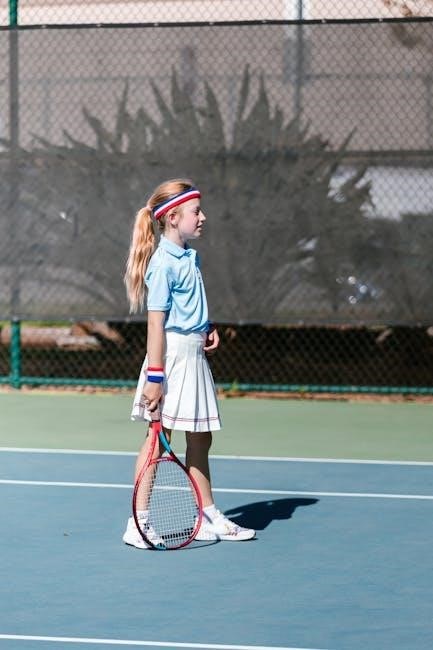
Serving Drills for Beginners
The serve is a crucial element in tennis, and beginners need specific drills to develop consistency and power. Begin with the “Toss Practice” drill. Focus solely on perfecting the ball toss. The toss should be consistent, slightly in front of your hitting shoulder, and at a height that allows for a comfortable swing. Repeat this until the toss becomes second nature.
Next, implement the “Service Motion Drill.” Go through the entire serving motion without hitting the ball. Concentrate on the smooth transfer of weight, the proper grip, and the full follow-through. This helps engrain the correct technique.
Progress to “Target Practice.” Aim your serves at specific targets in the service box. Start with large targets and gradually reduce their size as your accuracy improves. This develops precision and placement.
Incorporate “Short Court Serves.” Serve from closer to the service line to build confidence and consistency. Focus on getting the ball in the service box without worrying about power.
Introduce “Full Court Serves” once you feel comfortable with the short court serves. Now, focus on adding power and spin while maintaining accuracy. Remember to keep your eye on the ball throughout the serve motion.
Consistent practice of these drills will gradually transform your serve from a weakness into a weapon.
Volley Drills for Beginners
Volleying is an essential skill in tennis, requiring quick reflexes and precise technique. For beginners, mastering the basics is crucial. Start with the “Wall Volley Drill.” Stand a few feet from a wall and gently volley the ball back and forth. Focus on keeping your wrist firm and using short, punchy movements. This drill enhances your feel for the ball and improves reaction time.
Progress to the “Partner Volley Drill.” With a partner on the opposite side of the net, gently volley the ball to each other. Concentrate on maintaining a stable base, keeping the racket head up, and meeting the ball out in front of your body. This drill reinforces proper volley technique.
Introduce the “Approach and Volley Drill.” Start at the baseline and approach the net, hitting a volley as you move forward. This simulates a game situation and helps you develop the ability to transition from the baseline to the net effectively.
Incorporate the “Reaction Volley Drill.” Have your partner feed balls at varying speeds and directions, forcing you to react quickly and adjust your volley accordingly. This drill enhances your reflexes and adaptability.
Finally, practice the “Low Volley Drill.” Focus on bending your knees and getting low to the ball, maintaining a stable base, and using a short, upward swing to lift the ball over the net. These drills will develop solid volleys.
Footwork Drills for Tennis Beginners
Footwork is the foundation of good tennis. Beginners must develop agility and efficient movement. Start with the “Shadow Swings Drill.” Without a ball, mimic forehand and backhand strokes while moving your feet. This reinforces proper foot placement and balance. Focus on short, quick steps and maintaining a low center of gravity.
Introduce the “Cone Drill.” Place cones in a line and shuffle sideways between them, touching each cone. This improves lateral movement and agility. Then, place cones in a T-shape and practice sprinting forward, shuffling sideways, and backpedaling; This enhances multi-directional movement.
Incorporate the “Split Step Drill.” Practice the split step just before your opponent hits the ball. This prepares you to move quickly in any direction. Combine the split step with shadow swings to simulate game situations.
Progress to the “Suicide Drill.” Sprint to the service line, touch it, sprint back to the baseline, then sprint to the net, touch it, and sprint back to the baseline. This builds endurance and improves speed.
Utilize the “Spider Drill.” Start in the center of the court and sprint to various points, such as the corners and sidelines, returning to the center each time. This enhances court coverage and agility. These drills will help you move efficiently.
Crosscourt Rally Drills
Crosscourt rallies are fundamental to tennis strategy, improving consistency and control. Beginners should start with the “Mini-Court Crosscourt Drill.” Use a smaller court area, focusing on hitting the ball deep and crosscourt. This helps develop accuracy and consistency. The goal is to maintain a rally of at least ten shots.
Next, progress to the “Full-Court Crosscourt Drill.” Position players at the baseline, hitting only crosscourt. Emphasize depth, spin, and placement. Aim for consistent shots that land within the service box. This drill builds endurance and improves directional control.
Introduce the “Crosscourt Angle Drill.” Focus on creating sharper angles to pull your opponent off the court. This requires precise placement and controlled spin. Gradually increase the angle as your consistency improves.
Incorporate the “Crosscourt Depth and Spin Drill.” Practice hitting deep, topspin shots that bounce high. This makes it difficult for your opponent to attack. Focus on using your legs and generating racket head speed.
Advance to the “Crosscourt Recovery Drill.” After hitting a crosscourt shot, quickly recover to the center of the baseline. This drill improves court coverage and prepares you for the next shot. Consistency, depth, and controlled spin.
Mini-Tennis Drills for Beginners
Mini-tennis is an excellent way for beginners to develop fundamental skills in a confined space. Start with the “Contact Point Focus Drill.” Players stand within the service boxes, focusing on making clean contact with the ball. The goal is to develop a feel for the racket and control over the ball.
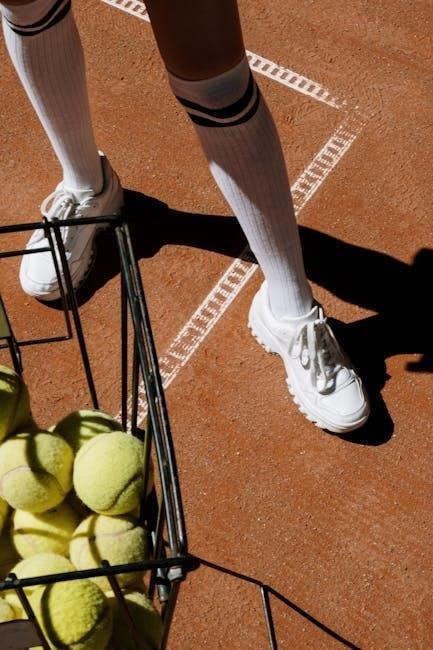
Progress to the “Rally for Consistency Drill.” Players rally within the service boxes, aiming for consistent, soft shots. Focus on keeping the ball in play and developing a rhythm. This drill improves hand-eye coordination and basic rally skills.
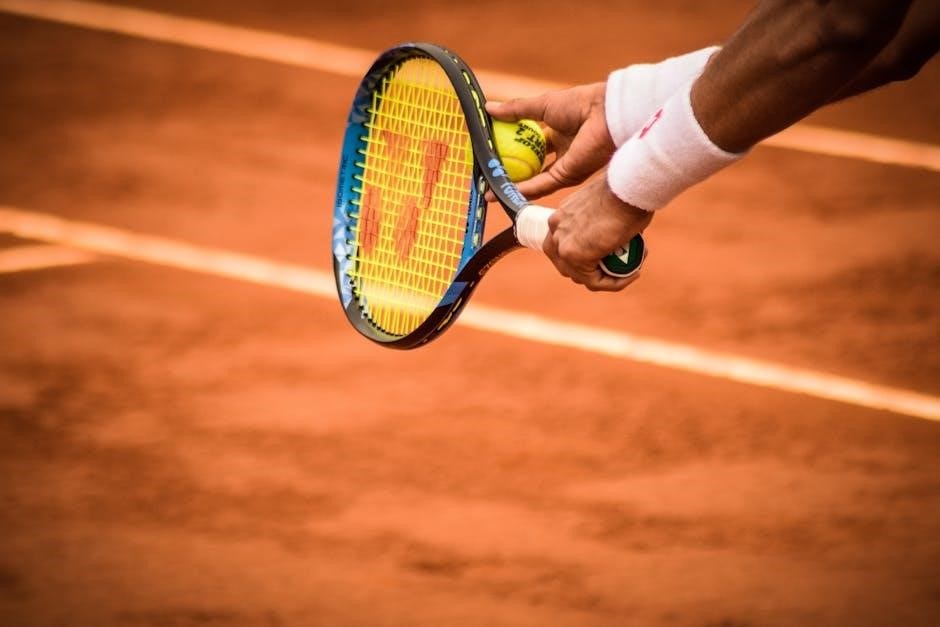
Introduce the “Directional Control Drill.” Players aim to hit the ball to specific areas within the service boxes. This develops directional control and shot placement. Use cones or targets to make the drill more challenging.
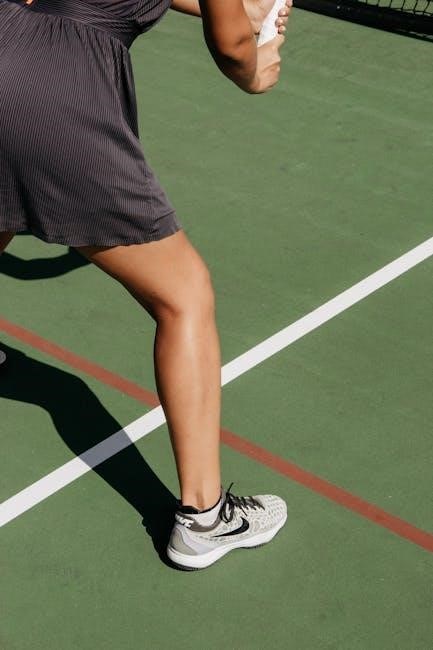
Advance to the “Serve and Return Mini-Tennis Drill.” Players practice serving and returning within the service boxes. This drill combines serving, returning, and rallying in a smaller space. It improves overall court awareness and reaction time. These drills build confidence and prepare beginners for full-court play.
Barrier Tape Tennis for Beginners
Barrier tape tennis is a fantastic method for beginners to improve their rallying skills in a structured environment. This involves using barrier tape to create smaller court areas, promoting more frequent ball contact and focused practice.
Start with the “Controlled Rally Drill.” Divide the court into smaller sections using barrier tape. Players rally within these sections, focusing on maintaining consistent shots and keeping the ball in play. This helps develop accuracy and control.
Progress to the “Target Practice Drill.” Place targets within the taped areas and have players aim for them while rallying. This improves directional control and shot placement. Vary the target positions to challenge players.
Introduce the “Movement Drill.” Players move within their taped area to reach and return the ball. This enhances footwork and agility, crucial for court coverage. Encourage quick steps and balanced positioning.
Incorporate the “Tap-Hit Privilege Drill.” For beginners struggling with rallies, allow them to tap the ball once before hitting it over the net. This helps build confidence and improves their ability to make contact.
Advance to the “Barrier Tape Serve and Return Drill.” Players practice serving and returning within the taped areas. This combines serving, returning, and rallying in a confined space, enhancing overall court awareness and reaction time. This method builds confidence and improves rally consistency.
Integrating Drills into a Beginner’s Practice Routine
Effectively integrating drills into a beginner’s tennis practice is essential for skill development and maintaining engagement. Start with a structured warm-up, including dynamic stretches and light cardio, to prepare the body for activity and prevent injuries. Follow this with fundamental drills focusing on grip, stance, and basic strokes.
Prioritize consistency over intensity initially. Begin with short, focused sessions on forehand and backhand groundstrokes, using target practice to improve accuracy. Gradually increase the duration and difficulty as the player progresses. Incorporate serving drills early on, emphasizing proper technique and consistency rather than power.
Mix up the drills to prevent monotony. Alternate between groundstroke, volley, and serving drills to keep the practice varied and engaging. Include footwork drills to enhance agility and court coverage. Regularly assess progress and adjust the routine accordingly. Provide constructive feedback and encouragement to maintain motivation.
Conclude each session with mini-tennis to apply the learned skills in a game-like situation. End with cool-down stretches to promote recovery. Remember that consistent, well-structured practice, incorporating a variety of drills, is key to a beginner’s tennis development. Focus on gradual improvement and enjoyable learning experiences.
